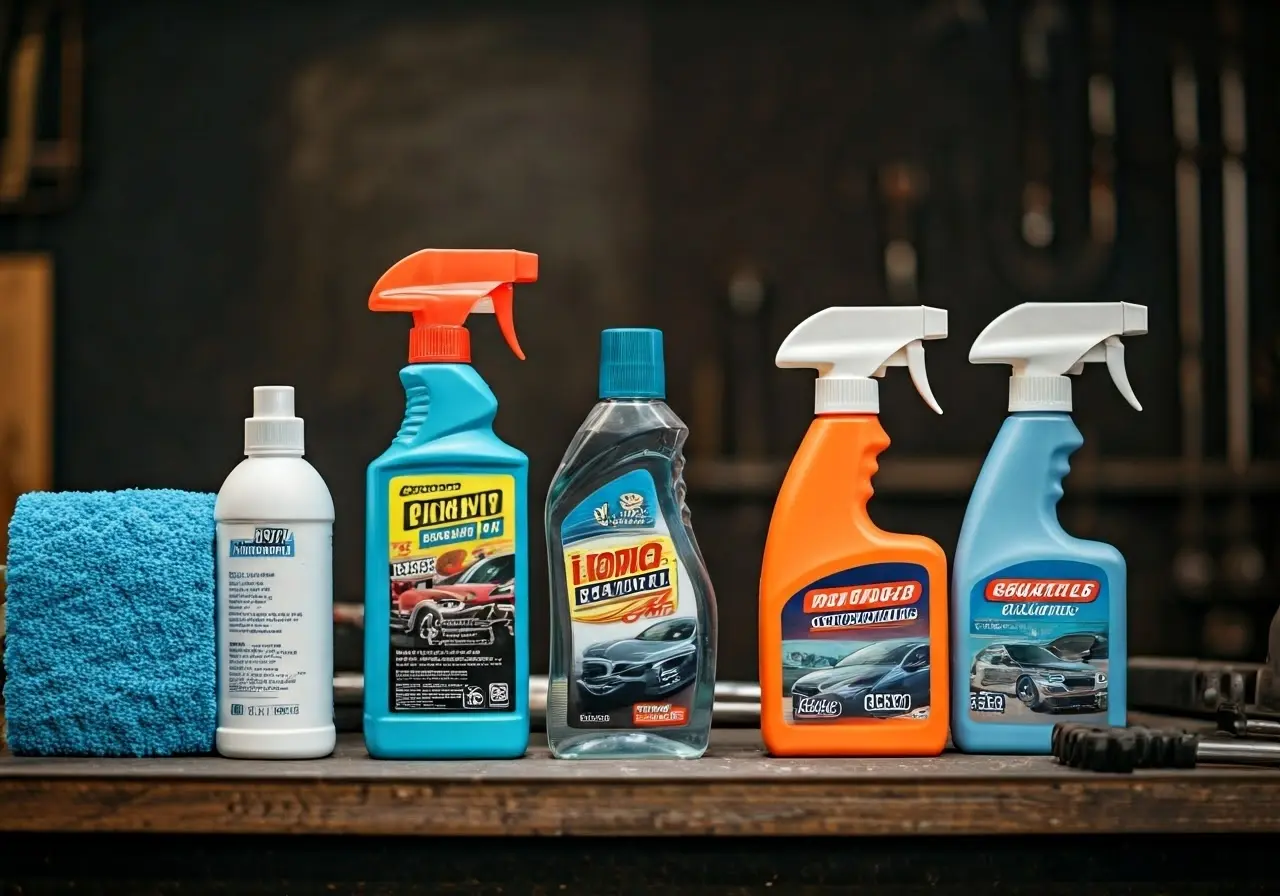

12 Common Auto Detailing Mistakes and How to Avoid Them
Auto detailing is essential for maintaining your car’s appearance and longevity, but even the most seasoned car enthusiasts can make mistakes. In this guide, we’ll explore the common pitfalls in auto detailing and offer practical tips to avoid them.
1. Skipping the Pre-Wash Rinse
Neglecting to rinse your car before washing can lead to scratches. Always start with a good rinse to remove loose dirt.
A thorough pre-wash rinse may seem like a minor step, but it’s a critical one if you want to avoid inflicting micro-scratches on your car’s surface. When dirt particles are left on your car during washing, they can act like sandpaper against your paint when you scrub. Always make sure your car is rinsed to remove as much loose dirt as possible before proceeding with other steps. Interestingly, many enthusiasts underscore the importance of pre-wash rinsing because it can serve as the first shield against potential damage. It’s akin to giving your car a quick dust-off before the main event.
2. Using Dish Soap as a Cleaner
Dish soap can strip away wax and damage your car’s finish. Instead, use a soap specifically designed for auto washing.
Dish soap might seem harmless—I mean, we use it on our toughest kitchen grease, right? However, what works wonders on plates doesn’t translate well to car paint. Dish soap disrupts your car’s protective wax layer, making it vulnerable to elements that can damage it over time. Opt for a purpose-formulated car shampoo designed to leave your vehicle’s finish intact and brilliantly sheen. Ensuring the right type of car soap is part of your car care routine can be the difference between a dull, scratched paint job and a gleaming one. You can learn more about avoiding these mistakes to enhance the outcome.
3. Forgetting to Clean the Tires First
Tires can throw dirt onto freshly cleaned surfaces. Always start your detailing process by tackling the tires.
Starting with your tires might not sound intuitive if you’re focused on perfecting your car’s paint, but it’s a fundamental sequence in effective auto detailing. Tires are notorious for harboring mud, dirt, and grime which can be splattered onto freshly cleaned panels—kind of like making a mess just after tidying up! By first focusing on your tires, you avert this mess across your sparkling surfaces, saving time and, importantly, preserving the aesthetics of the areas you’ve already tackled. Furthermore, cleaning your tires first allows any runoff, which may contain tire grime, to be washed away in subsequent steps.
4. Scrubbing with a Single Bucket
Using a single bucket for wash and rinse can cause dirt re-transfer. Opt for a two-bucket method instead.
When you only use one bucket, you’re essentially transferring dirt and grime back onto your car each time you dip your wash mitt into that murky water. The two-bucket method solves this issue by separating the wash water from the rinse water. Use one bucket for your soapy water and the second for rinsing the mitt between applications. This way, the dirt gets left behind in the rinse bucket, not on your car’s paint. For a deeper dive into techniques, check out detailing essentials that can ease the cleaning process.
5. Applying Polish Incorrectly
Too much polish can lead to uneven surfaces. Apply it sparingly and use a buffer to evenly distribute.
Polishing properly is not just about spreading the product; it’s about getting the desired shine and removing all imperfections without leaving new ones. Over-application can result in a messy, swirled surface. Always work polish into the car’s surface using a buffer at a low speed, gradually increasing as you achieve an even application. Remember, a small amount goes a long way. By using this technique, you’ll ultimately use less product, saving money and preserving extra gloss for future detailing sessions.
Moreover, consider the value of a random orbital buffer. This tool can significantly reduce the effort and time involved in achieving a flawless finish. While hand polishing is beneficial for small areas or touch-ups, a buffer ensures consistent, professional-grade results, making your vehicle’s paintwork pop.
6. Overlooking the Clay Bar Step
Skipping the clay bar process can leave contaminants on the paint. Always clay after washing for a smooth finish.
The clay bar is an often overlooked yet essential part of the detailing process. After washing and before polishing, it removes stubborn contaminants like industrial fallout, sap, and tar that regular washing leaves behind. Its thoroughness ensures that your car’s surface is polished over without grinding these contaminants back into the paint, potentially causing damage. For a glass-smooth finish, a clay bar treatment is unmatched and sets the stage for any subsequent polish or sealant, boosting the effectiveness of the products applied afterward. Dive deeper into essential detailing tips to understand importance of clay barring.
7. Neglecting Interior Detailing
A clean exterior is great, but don’t forget the interior. Regularly dust, vacuum, and condition to maintain it.
Interior detailing isn’t just about looks—it’s about maintaining your driving experience. Regular dusting, vacuuming, and conditioning not only keep things looking fresh but also prevent wear on surfaces like dashboards, seats, and carpets. Dust can scratch surfaces, and in time, dirt can lead to fading and tearing. Consider interior detailing as vital as exterior, helping maintain the car’s value and ensuring you’re always welcomed into a pleasant environment. Don’t just focus on the exterior shine; nurture the space you inhabit while driving.
An effective tool for interior maintenance is a vacuum cleaner with attachments tailored for car use. These tools can reach into small crevices where grime tends to hide, ensuring a thorough clean. Interior sprays and conditioners will further protect surfaces from UV damage and cracking, throughout changing seasons.
8. Cleaning in Direct Sunlight
Direct sunlight dries cleaning solutions too quickly, leading to streaks. Always work in a shaded area.
The warm rays of the sun might feel great, but they can sabotage a good detailing job. When cleaning products dry too quickly, they can leave streaks and water spots that are tricky to remove. Always aim to detail your car in the shade or, if that isn’t possible, during cooler, cloudier parts of the day. A car’s surface temperatures can increase dramatically under the sun, making it tough for polishes and waxes to apply evenly. To achieve the flawless finish you’re aiming for, shade is your ally during detailing endeavors.
In environments where shade is scarce, a portable canopy can be a wise investment. By providing coverage over your car, it shields you and your vehicle from the sun’s direct heat and allows for a controlled detailing environment that can improve the quality of your work.
9. Using Incorrect Tools
Using abrasive tools or towels can damage your car. Invest in microfiber cloths and soft brushes instead.
Use of appropriate tools is the cornerstone of effective detailing. While it might be tempting to use household sponges and bath towels, these can scratch and dull your car’s paint. Microfiber cloths, on the other hand, are soft, non-abrasive, and designed to lift dirt without causing harm. Similarly, choosing the right brush for specific jobs—soft bristle brushes for wheels and detailing brushes for interiors—will make a marked difference in results. For your efforts to yield a car that gleams with pride, quality tools are non-negotiable.
High-quality tools don’t just improve the detailing process; they make it more enjoyable. When you can rely on your equipment to be effective and safe, the task becomes a satisfying endeavor rather than a chore—achieving professional results with less effort.
10. Failing to Protect Surfaces
Failing to apply wax or sealant leaves your paint vulnerable. Make protective coatings a part of your routine.
Without a wax or sealant, even the best cleaning job is short-lived. These layers act like a defense shield, fending off dirt, debris, and harmful rays. By absorbing these attacks on behalf of your paint, wax or sealant extend the life and luster of your car’s aesthetic finish. Ensuring these are part of your routine not only keeps your car looking pristine but also reduces environmental wear and tear, making the maintenance process simpler over time.
There are various types of waxes—natural and synthetic—and modern sealants designed to offer extensive protection. With advancements in technology, products like ceramic coatings now offer more durable protection, bridging the gap between wax and new-age solutions. Choose the one that aligns with your car’s specific needs and climate conditions for optimal protection.
11. Ignoring Small Paint Chips
Address paint chips immediately to prevent rust. Keep touch-up paint on hand for quick fixes.
The reality of driving often means encountering flying debris, leading to small but potentially harmful paint chips. If left untreated, these minor blemishes can lead to major rust and damage. Always have a touch-up kit readily available for these instances, allowing you to swiftly address and seal these chips, preventing them from developing into bigger problems.
Think of it as first aid for your car’s exterior. Regular inspections help catch these chips early before they have a chance to worsen. Small, immediate fixes can prevent costly repairs down the line, ensuring your vehicle maintains its showroom appeal for longer.
12. Not Maintaining a Regular Schedule
Infrequent detailing can lead to damage over time. Create a schedule to keep up with maintenance tasks.
Good maintenance is proactive, not reactive. A regular detailing schedule helps ensure that neglect doesn’t allow minor issues to escalate. Set reminders for not only deep cleanings and polish sessions but also for simpler checks like tire pressure and fluid levels. By doing so, you extend not just the aesthetic but the operational life of your vehicle, saving expenses related to avoidable repairs. The saying holds: a stitch in time saves nine.
Creating a detailing calendar can also integrate seamlessly with other maintenance routines. Aligning detailing tasks with regular maintenance check-ups helps you remember and benefit from overlap in tasks, optimizing time efficiency.
Latest Posts


Why Tinting Car Windows is a Must for Your Vehicle in Winston-Salem

Is Ceramic Car Coating Near Me Worth the Investment for My Car?

15 Advantages of Window Tinting Salisbury NC for Your Car

Shine On: Why Ceramic Coating in High Point, NC Is a Must for Your Car


